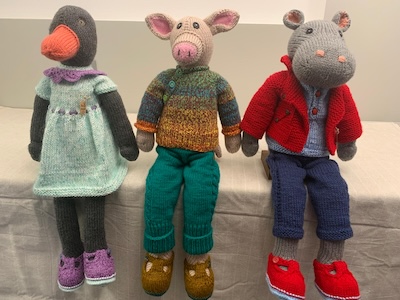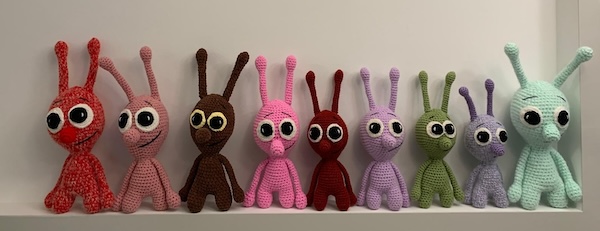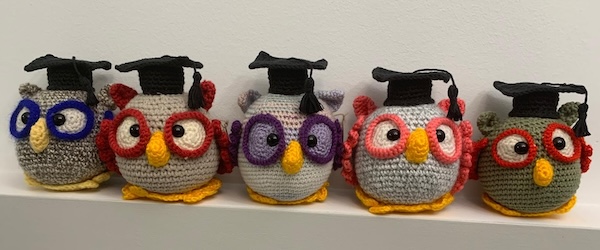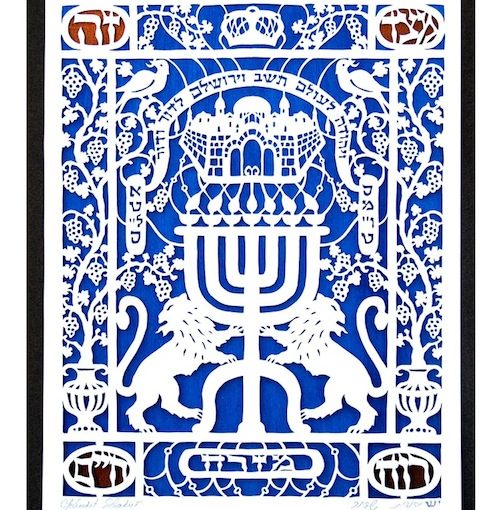Lea Bilot with some of her bearded gnomes. (photo from Lea Bilot)
Some artists find their niche, their preferred way of expression, early in life. For others, it takes longer, sometimes decades, to discover their creative outlet. Lea Bilot belongs to the second category.
For the past few years, Bilot has been knitting and selling her whimsical stuffed toys at fairs and craft markets around Greater Vancouver.
“I was born in Vilnius, Lithuania. That was where I grew up and got married,” she told the Independent. Later, her family immigrated to Israel, where they lived for 26 years. They came to Canada in 2015, following their adult children.

“I was never artistic before,” she said. Though perhaps she was, without realizing it. Creativity doesn’t usually spring out of nowhere. It surely shimmered inside her all along, finding unconventional channels among the demands of hard work and three growing children.
“When we came to Vancouver, my husband and I started flipping houses,” she said. “We did it for a few years, but then COVID happened. Everything stopped. I didn’t know what to do. My husband found a job, but I was bored out of my mind.”
She searched for an avenue to apply her fertile imagination.
“We went to our community centre once, and there was a craft fair there. I liked the knit toys someone was selling, but I thought: I could do better. And the idea stuck.”
Never having made a knit toy before, Bilot did some research on the internet.
“I don’t speak good English,” she said. “So, I contacted a friend in Israel and asked if she could find me some books in Russian on the subject. She did and sent them.”
Bilot read all the books and then began to experiment.
“At first, I knitted some children’s clothing, but I don’t do that anymore,” she said. “Now, I concentrate on toys. I don’t copy what the books say either. I improve on them, make changes. I might use legs from one toy, hats from another, whatever fits my vision. Sometimes, I just follow my muse. Or I might find something new on the internet. There are several groups on Facebook, and we share information. We also help each other, when one of us hits a snag.”

The variety of toys Bilot creates is astounding. Her output includes some common animals – dogs, cats, bears and rabbits – as well as owls in graduation hats, aliens with antennas and gnomes with beards. Each one has its own expression; no two are identical. For the winter holiday markets, she makes colourful Christmas trees with legs and hats, and snowmen decorated with buttons.
“I don’t knit snowmen – I make them from socks,” she said. “And, for my Christmas trees, I started to crochet. I’ve only been doing it for a few months.”
She derives her ideas from everywhere.
“I once saw a man on the street with a big bushy beard. He was a short and fat older man, and his beard was white. I thought: that is my gnome.”
Her home is half living space, half workshop.
“I have so much yarn now, I need to put it somewhere I can easily access,” she explained. “I put all my clothing in cardboard boxes, and my yarn into my dresser’s drawers.”
Most of her yarn is acrylic.
“Some children are allergic to wool. They like to hug their toys, kiss them, sleep with them. I have to use acrylic for the toys,” she said. “And I buy only expensive yarn: from Denmark, from Turkey, from Lithuania. I don’t use cheap local yarn – it doesn’t last long. Children put their toys to hard use. The toys need to be washable and durable.”

From design to execution to sales, Bilot enjoys every step of the toy-making process.
“I love making them. Sometimes, when I want to finish one, I wouldn’t sleep for half the night. It is such a joy making all those details – skirts, boots, glasses – and coming up with new concepts, new patterns.”
She loves selling the toys as well.
“People don’t always buy them, but, whenever they pass my table, they smile. Women, children, even men – they all smile. Children are very well behaved, too. They would handle my toys, hug them – I make them soft and extremely huggable – but they don’t demand that parents buy them, don’t throw fits. It’s always a pleasure to be around them. That’s why I don’t offer my toys to any stores. I want to witness those smiles.”
Bilot sells her toys several times a year at craft fairs at community centres, schools and even universities.
“There are websites for artisans like me,” she said. “They list all the fairs. I would drive to those fairs first, see what they are selling, what the conditions are, before applying to them as a vendor for the next time. My husband helps, he drives me around. And my daughter helps with the application process.”
When asked if she gets any income out of her full-time toy-making hobby, Bilot laughed. “I cover the price of yarn,” she said, “and a bit above it, but not much. Mostly, I do it for the fun of it.”
To see Bilot’s creations and be ready when she next tables at a market, visit instagram.com/leas_knittings.
Olga Livshin is a Vancouver freelance writer. She can be reached at olgagodim@gmail.com.


